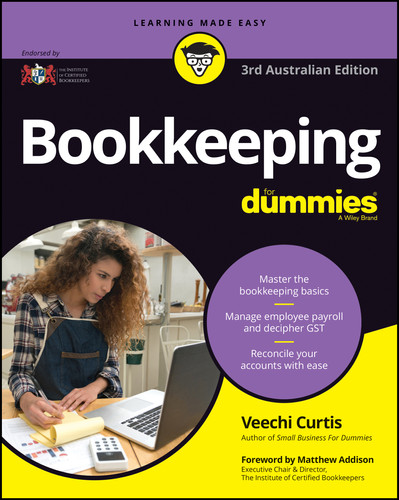Introduction
I first started working as a bookkeeper in my late teens, doing handwritten books in leather-bound journals down by the docks in my hometown of Edinburgh, Scotland. Later, I emigrated to Australia, where I got a job working as a bookkeeper in the Blue Mountains, west of Sydney. There I worked with first-generation accounting software, substituting the peace of those inky journals for a battle of wills (myself versus the computer) that required a bizarre mixture of programming skills and native cunning.
By my late twenties, I had a small business of my own, employing four staff and offering bookkeeping services to local businesses. I finished a degree in accounting (which contributed surprisingly little to my bookkeeping expertise), and started writing for magazines and newspapers reviewing accounting software. In the following years, I wrote a fair few For Dummies titles, including MYOB Software For Dummies and QuickBooks For Dummies.
Even with all this experience behind me, I was in a bit of a quandary as to how to structure the project that you have in your hands right now — Bookkeeping For Dummies. I started looking around at other books about bookkeeping, and found that these books fell into two camps. The first camp took a traditional approach, explaining debits and credits, general ledger postings, and so on, all with the assumption that you’re doing books by hand. The second camp were accounting software how-to guides, such as the books I’d written about using MYOB or QuickBooks.
What I felt was missing was a book written for bookkeepers that explained the principles of bookkeeping — the art of bookkeeping, if you like — in the context of doing business in the 21st century. I’m hoping that the book that fills that gap is the one you’re holding in your hands.
For this third edition, I’ve updated every chapter to reflect the major changes that have affected the bookkeeping industry in the last few years. I talk more about cloud accounting and working with bank feeds, and explain new initiatives such as Single Touch Payroll. For those bookkeepers wanting to go out on their own, I’ve updated the chapters about the regulatory framework for bookkeeping and starting up your own bookkeeping business.
About This Book
This book talks about bookkeeping for all sizes of business, both large and small. I realise that you may be a business owner trying to figure out how to do a simple set of books for your new business, or you may be a seasoned bookkeeper working for a multimillion-dollar enterprise. I address both kinds of bookkeeper when writing this book, starting with the basics of bookkeeping, and building to more complex topics later on.
Foolish Assumptions
Because I’m so blindingly sensible, I don’t make any foolish assumptions about you, dear reader. I don’t assume that you have any bookkeeping experience or even that you’ve worked in a business before (although it’s possible, of course, that you’re a bookkeeper extraordinaire with 30 years’ experience under your belt). All I assume is that you are at least vaguely interested in bookkeeping and the results that the process yields.
Icons Used in This Book
Throughout this book you find icons in the margins to help you navigate through the text. Here’s what these icons mean:
Where to Go from Here
Bookkeeping For Dummies isn’t a gripping novel to be read from cover to cover. This book is designed (all 21 bite-sized chunks) so you can pick it up at any point and just start reading.
If you’re a business owner and you’ve never done bookkeeping before, and you’re looking to set up a bookkeeping system for your own business, I recommend you read Chapters 1 to 10 before doing much else (although you can skip Chapter 9 if you don’t have any employees). On the other hand, if you’re an experienced bookkeeper looking to expand your skills, by all means skim read the first few chapters, but start reading with more seriousness from Chapter 11 onwards.

 You find this icon next to stuff relating to GST or taxation (ah, such fascinating topics).
You find this icon next to stuff relating to GST or taxation (ah, such fascinating topics). Tie a knot in your hankie, pin an egg-timer to your shirt but, whatever you do, don’t forget these little nuggets.
Tie a knot in your hankie, pin an egg-timer to your shirt but, whatever you do, don’t forget these little nuggets. This icon points the way to doing your job better, faster and smarter.
This icon points the way to doing your job better, faster and smarter. Real-life stories from bookkeepers who’ve been there provide all the history lessons you could ever want.
Real-life stories from bookkeepers who’ve been there provide all the history lessons you could ever want. A pitfall for the unwary. Read these warnings carefully (then you can’t say no-one told you …).
A pitfall for the unwary. Read these warnings carefully (then you can’t say no-one told you …).